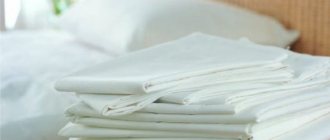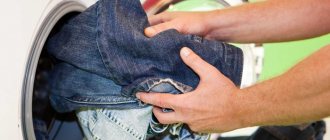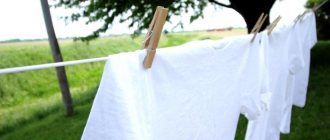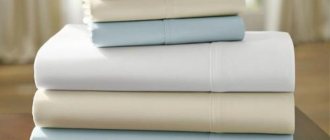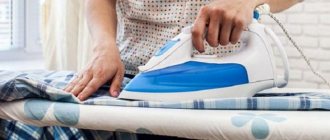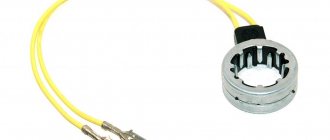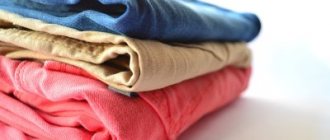Bed linen should always be kept clean. This is the only way to ensure quality and healthy sleep for yourself and all family members.
It would seem that washing bed linen is devoid of any tricks. In fact, there are many small but useful secrets that help not only keep your bed fresh, but also significantly increase the service life of sheets, pillowcases and duvet covers.
Read the article about how to properly wash, dry and iron bed linen made from different types of fabric in an automatic washing machine (at how many degrees, in what program) and manually.
Preparation for the process
Preparing bed linen for washing is a mandatory condition that should not be neglected.
Basic recommendations:
Go through your laundry, sorting it by color and fabric type. White, light, colored and black items are washed separately.- Separate the laundry into sets if they have different colors.
- Study the manufacturer's information on the label.
- Shake the product several times to remove dust.
- Turn pillowcases, duvet covers and mattress covers inside out. Remove dirt that has accumulated in the corners.
If there are difficult stains on the fabric, for example from blood or wine, they need to be washed in advance.
Recommendations and tips
To get an excellent result, you need to know the rules and important nuances.
- Before washing, bedding must be turned inside out. Thanks to this action, you can get rid of dirt that accumulates in the corners of the product.
- Before washing delicate fabrics, stains should be treated with a stain remover. But linen or cotton products do not require such attention. You just need to adjust the washing mode.
- It is better to spin colored laundry at a speed of no more than 800. This way, creases do not form on the fabric. And the dye will remain in its place and will not wash out.
- A new bedding set must be washed. Fabrics are sometimes treated with an additional solution to make the fabric shiny when packaged. Therefore, you need to remove all unnecessary substances from the kit.
- It is better to wash baby clothes with baby soap. It practically does not cause allergies.
- The washing machine is loaded with bed linen no more than 2/3 of the total volume. It should move freely in the drum.
- When drying colored laundry, turn the item inside out. This way the color of the bed linen will not fade and will retain its original appearance.
- Bed linen should be ironed damp after washing. This will make the work much easier and require less effort and time.
- Clean the washing machine. To do this, start it empty, adding special tools.
Clean linen makes the apartment comfortable.
Clean linen is an indicator of the well-groomed and beautiful apartment. To ensure that it always remains so, certain rules must be followed. Perform washing based on the fabric of the product, the selected mode and program.
Remember the recommendations or review them every time you wash your clothes.
Use different products for adults and children to prevent allergies. Before purchasing products, you should carefully study their composition and also check the expiration date. Follow the recommendations and tips for using bedding. And it will last for many years.
How to wash in an automatic washing machine?
Machine washing of bed linen is carried out according to the following instructions:
- Load the items into the drum of the washing machine.
- Select the appropriate washing mode.
- Set the spin speed and water temperature.
- Add or add detergent.
- Turn on the “Extra Rinse” function. It is used when washing with granular powders or with a large load.
- Start the wash cycle. After its completion, the laundry is removed from the drum and sent to dry.
Many modern cars are equipped with the EcoTime function. It can be used if there is one set of bed linen in the drum.
In what mode, at what temperature?
When choosing a washing mode, you need to start from the type of fabric from which the laundry is made. Modern machines are equipped with many useful functions, so you can choose the best way to care for your bedding.
Basic recommendations:
“Silk” mode is suitable for washing satin, silk and wool;- delicate or gentle washing is intended for the care of synthetic fabrics, jacquard and chintz items;
- the “cotton” mode is suitable for washing natural fabrics (cotton and linen);
- washing with pre-soaking is required for heavily soiled laundry;
- The “Quick Wash” mode involves processing items for 15 minutes; it is chosen when the laundry is clean, but needs to be refreshed.
In most cases, you can limit yourself to a maximum washing temperature of 60 degrees.
Modern detergents allow you to remove dirt even in cool water. If it is not hotter than 40 degrees, the fabric retains its density and color saturation longer.
Temperature recommendations:
- for linen and cotton: 60 degrees;
- for synthetics: 40 degrees;
- for delicate fabrics: 30 degrees;
- for colored fabrics: 40 degrees.
White bed linen can be washed in hot water, but only if it is made of cotton or linen.
Detergent
The choice of detergent depends on a number of factors:
Color. If the products are painted, you need to choose a powder labeled Color.- Compound. Aggressive detergents containing chlorine are not suitable for machine washing.
- Bleach. Its presence in the composition is acceptable provided that white laundry is to be washed.
- Release form . Liquid detergents and gel capsules can be rinsed well and dissolved in cool water.
To ensure that the laundry has a pleasant aroma, does not electrify and retains color saturation longer, you can add fabric conditioner to the washing machine.
Spin
Spinning at high speeds is acceptable when washing durable fabrics (cotton, linen) . If the product is made of delicate fabric, then it is reduced to 400-600 rpm.
Delicate fabrics require avoiding automatic drying, or reducing the spin speed to minimum values.
Loading
Each washer has its own capacity limit. Drum loading depends on the model. Compact machines are loaded with 3-4 kg, standard machines - 5-9 kg. The user’s task is to load the drum without exceeding the norm. This is the only way to ensure high-quality washing of products.
If your SMA does not have automatic weighing, you have to estimate your weight by eye or calculate it by checking the tables:
- Sheet - 0.4-0.5 kg;
- Duvet cover - 0.5-0.7 kg;
- Bedspread - 0.6-0.8 kg;
- Pillowcase - 0.15-0.25 kg.
When loading, you need to take into account the volume of things - they must rotate freely inside the machine, otherwise the quality of the wash decreases. It is recommended to fill the drum halfway - this way the products will be washed as carefully as possible. By filling the drum to capacity, you risk the beauty of your laundry.
How to properly wash by hand?
You can wash your bed linen by hand. This requires some effort, but this method of processing is considered more gentle. Hand washing is especially important for caring for delicate fabrics.
Step-by-step algorithm of actions:
- Fill a large basin or bathtub with warm water.
- Dissolve detergent in it. You need to choose either a universal liquid composition or a powder intended for hand washing. The packaging of detergent should have an icon in the form of a basin with a hand placed in it.
Soak bedding in water.
The time it is kept in the washing solution depends on the degree of contamination of the fabric. General recommendations: for white items – 1-3 hours, for colored fabrics – no more than 60 minutes.- Remove difficult stains. If the material allows, you can use a brush with soft bristles.
- Using gentle squeezing movements, stretch the entire surface of sheets, pillowcases and duvet covers step by step.
- Rinse things in warm water. To make them soft, you can add fabric softener.
- Wring things out and send them to dry.
It is necessary to rinse the laundry until the water stops foaming, since the detergent particles remaining in the fabric fibers will slowly destroy them. In addition, with constant contact with the skin, they can provoke the development of allergies.
What to wash: choosing a detergent
For cotton, satin and other natural fabrics, you can use the universal powder that you usually use. The disadvantage of powders is that their particles easily get stuck between the fibers. Due to close contact with laundry, an allergic reaction may occur. For this reason, only hypoallergenic products are used to care for baby’s bed.
Various gels, liquids and capsules will help you deal with stains well. Their selection in stores and supermarkets is huge. For white items, you can use a product with bleach. For people of color, choose special products. They contain components that help maintain color for a long time.
For silk, cambric and other delicate materials, you should choose a detergent for silk or wool, delicate linen. Using conditioner will give the bed softness and a pleasant aroma. Silk items should be rinsed in an antistatic agent.
How to wash it - video:
How often?
Bedding should be washed as it gets dirty. Even if no noticeable stains appear on the fabric, it is recommended to change it every 7 days . In a week, the material does not have time to become salty, but it is difficult to call it fresh.
Linen absorbs sweat and other secretions and acquires an unpleasant odor. Therefore, you need to wash it at least once every 7-10 days. If a person sweats a lot, then this procedure should be performed more often.
Clean linen is the key to healthy sleep. Such bedding does not spread dust mites or allergens. Read more here.
How to remove yellowness?
Many of us have noticed how, after a certain period of time, snow-white bed linen begins to lose its original appearance. They turn gray or unpleasant yellow spots appear on the fabric. The reason for this phenomenon lies in the powders used. Usually there are elements that react with hardness salts in the water, thereby coloring the material. In addition, yellowness may appear if bed linen is not used for a long time or when stored next to stale items.
In this regard, every housewife is interested not only in how to wash bed linen in a washing machine, but also in ways to remove yellow stains. And there are a great many of them. At the same time, not every fabric can be bleached. It is recommended to dry clean laundry made from delicate materials.
Today, in almost any hardware or specialty store you can find a wide range of whitening products that have their own characteristics. There are several varieties:
- Optical brighteners.
- Oxygen bleaching compounds.
- Chlorine-based products.
Optical brighteners are part of washing powders and only create a visual whiteness effect. In reality, bleaching as such does not occur, since these elements are not able to remove dirt and stains.
Oxygen bleaching compounds are safe to use because they do not contain chlorine. Such products work effectively even in cold water and can be used on delicate fabrics. Their only drawback is their high price.
Chlorine-based products, on the contrary, are cheap, have excellent disinfectant properties and effectively whiten things. However, they can only be used when washing clothes by hand. At the same time, such an equally effective remedy is not without its drawbacks. First of all, it can ruin the fabric; the product is unsafe for the respiratory tract and can often cause an allergic reaction. When working with this bleach, you must wear a mask and gloves, and you must also ventilate the room.
At the same time, you can solve the problem of how to wash bed linen in a washing machine and remove unwanted stains using other methods. And besides household chemicals, which are sold in many stores, some housewives prefer folk remedies that have stood the test of time. Let's look at the most common of them.
Features for products made from different materials
Depending on the type of fabric from which the set is sewn, the rules for caring for it will differ . There are picky materials that are not afraid of even boiling, but there are also expensive bedding that requires a delicate attitude.
Cotton
This is the most popular material for sewing pillowcases and sheets. It absorbs moisture well and is not afraid of automatic washing. In extreme cases, cotton underwear can be boiled.
When washed in water exceeding 60-70 degrees, bedding may shrink.
You can use bleaching agents for washing . Spin at maximum speeds is allowed. Linen has similar properties.
Synthetics
Synthetic fibers are included in most bedding sets. However, for a comfortable sleep, sheets and pillowcases with a high content of them are not very suitable, since they do not allow moisture and air to pass through well.
Features of washing such products:
- water temperature – up to 40 degrees;
- spin at a speed no higher than 600 rpm;
- detergent without aggressive components in the composition.
The more intense the impact on synthetic fabrics, the faster they deteriorate.
Blended fabrics
Blended fabrics are a combination of natural and synthetic fibers. Their content in a particular bedding set will vary. Therefore, before you start washing, you need to read the manufacturer's recommendations.
Basic care tips:
- Hand and machine washable.
- Avoid using chlorine bleaches.
- The water temperature is not higher than 40 degrees.
- Spin at speeds up to 500 rpm.
With proper care, high-quality PBC made from mixed fabrics will last up to 5 years.
Satin
Satin linen is very pleasant to the touch, so sleeping on it is a pleasure.
Caring for it must meet the following requirements:
- colored satin is washed at 40 degrees;
- white satin is washed at 60 degrees - this is the maximum temperature;
- spinning can be carried out at maximum speed.
For satin, machine and hand wash are acceptable. Read more about the rules for washing satin bed linen here.
Bamboo
Bamboo bed linen can be washed by hand or machine. Caring for it does not present any difficulties.
Rules to follow:
- Do not exceed the water temperature of 40 degrees.
- Do not use aggressive detergents.
- Do not push at maximum speeds.
It is recommended to opt for the “delicate wash” mode.
Silk
Silk underwear is expensive and requires careful handling. That is why all machines have a separate item in the “silk” mode.
Washing is carried out taking into account the following features:
- water temperature – no higher than 30 degrees;
- detergents - only liquid;
- spinning is not allowed.
To prevent silk sheets from becoming electrified and shiny, it is recommended to use an antistatic agent for bed linen. It is included in most air conditioners (Laska, Ushasty Nyan, Synergetic, etc.).
Percale
Percale consists of cotton and other fabrics (polyester, linen or silk). The threads are woven quite tightly, which allows you to wash such bed linen in a machine.
Basic recommendations:
- The water temperature during the first wash is no higher than 30 degrees. In the future, percale can be washed at 60 degrees.
- Use of neutral liquid detergents, without bleaching components in the composition.
- Spin speed is up to 800 per minute.
With proper care, percale bedding can withstand more than 1,000 washes.
Jacquard
Jacquard bed linen looks attractive and is very pleasant to the touch. Such sets are rightfully considered a luxury item.
Basic care recommendations:
- Hand and machine washable;
- water temperature – no higher than 30 degrees;
- Spin is disabled.
You can iron jacquard linen only from the wrong side.
Velvet
Velvet bed linen is very demanding to care for. This is a delicate and noble material, which has been and remains a symbol of high status and high cost.
Basic cleaning recommendations:
- Hand wash only.
- Avoid granular powder, bleaches and conditioners.
- Prohibition on any type of spin.
Do not rub velvet with a brush. You can use a sponge to remove dirt.
Silk
If you decide to wash silk bed linen in an automatic machine, you need to select the most gentle washing program, and it is better to turn off the spin cycle completely. You can first rinse the set in water with the addition of an antistatic agent - this way the laundry will retain its shine after washing.
The water temperature should not be more than 30℃. It is prohibited to use bleaches and stain removers when washing silk.
Children's sets
Features of caring for children's bedding:
- The kit must be washed before first use.
- Detergents should not contain aggressive components, including bleaches.
- Washing should be done regularly as sheets and pillowcases become dirty.
- It is recommended to load children's bedding separately from adult sets.
- Use natural cleaning products to remove stubborn stains.
The best bedding for a crib: satin, chintz, calico, linen, bamboo.
It is recommended to wash children's bedding with powder marked “Kids”. The composition of such products has a reduced level of surfactants and does not contain aggressive components.
At what temperature can it be washed?
The correct choice of temperature depends on whether the item in the automatic machine will not be damaged and how long it can last. Staying in hot water leads to a decrease in fiber strength and loss of aesthetic characteristics. Various materials are used to sew beds: cotton, satin, cambric, synthetics, silk, etc.
The choice of temperature depends entirely on the fabric used:
- For cotton, 60˚C is optimal, although for duvet covers and sheets with bright colors, set the temperature lower - 40 degrees. But old washed clothes can be sent into water, the temperature of which reaches 90 degrees.
- Wash white linen sheets at a temperature of 60 degrees, and if the material is impregnated with special compounds, lower it to 40˚C.
- The optimal temperature for satin is 40–60 degrees.
- For synthetic materials, heat the water to 30–40 degrees.
- Also wash bedding made of bamboo or cambric at 30–40 degrees.
- When washing silk, the temperature should not exceed 30 degrees. He is afraid of hot water and can get seriously hurt.
How to properly wash a bed in a washing machine - video:
To accurately determine the permissible temperature, carefully study the label. It contains all the necessary information, including spinning, ironing, and dry cleaning.
Note! Some products cannot be put into the machine, for example, velvet. They will have to be washed by hand. There will definitely be a corresponding icon on the label.
Do new ones need to be washed?
New bed linen must be washed. Before reaching the buyer, the fabric can gather dust for a long time in a warehouse, after which it is touched by many hands: weavers, packers, seamstresses, sellers. As a result, a certain amount of dust settles on it.
The first wash allows you to get rid of various contaminants and excess dyes, as well as make the material softer . The water temperature should be low, and detergents are sometimes completely abandoned.
Read more here.
Bed linen for children - washing features
Children's bedding should be washed on the "Baby clothes" mode at 50 - 60°C.
Carefully choose baby powder - it should not contribute to allergies on the child’s delicate skin.
Stains often appear on children's underwear. It’s easy to get rid of them - soak the items rubbed with laundry soap before washing. And then feel free to go wash it.
Attention! Wash children's underwear separately!
Removing difficult stains
To combat difficult stains, it is not necessary to use aggressive detergents. Available and inexpensive substances that everyone has in their home come to the rescue:
Blood. It can be removed using hydrogen peroxide, which is applied to a cotton pad and wiped with it until the stain disappears completely.- Urine, sweat and other secretions .
Baking soda and vinegar work well with such stains. They are applied one by one to the fabric, wait until the foaming reaction ends, leave for 30 minutes and wash as usual. - Oily spots . They can be easily removed using a mixture of salt and starch. The powder is applied to the stain, left for an hour, and then washed.
- Cosmetics stains . The most accessible means for removing them is laundry soap. It is grated, diluted with water and applied to the stain as a paste. After 30 minutes the item needs to be washed.
- Wine, coffee, tea . You can neutralize the coloring pigment with ammonia. It is applied to a cotton pad, which is used to wipe the stain until it disappears completely.
Additional washing tips
Any housewife dreams that bed linen will last a long time, look beautiful, and be comfortable for the body. There are many nuances, knowing which, you will achieve this without any problems. Let's look at the most important ones that will undoubtedly help you.
How to wash so that the fabric does not fade
To check whether a new color set is fading, you need to run a damp cloth over the front side of the linen. What to do if there are traces of dye left on the napkin?
It is necessary to fix and preserve the color of the products using one of the methods.
Soak the items for about an hour in one of the solutions:
- vinegar – 1 tsp. vinegar per 1 liter of water;
- salt - 1 tbsp. salt per 1 liter of water;
- with ammonia - 2 bottles per 5 liters of hot water;
After soaking, rinse thoroughly.
You can restore the brightness of products using bleach to restore color with the inscription “Color” on the packaging or special napkins for washing colored products.
The water during washing should not exceed 40 ⁰С, followed by a thorough rinse.
What to wash to make bed linen crunchy
In order for bedding made from cotton and linen fabrics to look snow-white, smell fresh, crisp and wrinkle less, it is starched - but only with soft starching.
You can use products from the store, or you can easily prepare a solution of natural starches at home.
So, we take potato, rice or corn starch.
Prepare a solution at the rate of 1 tsp. for 1 liter of water or 2 tbsp. for 6 liters of water. The water should be cold. Stir thoroughly, gradually adding hot water. Heat, stirring, until a transparent paste is obtained. Strain the finished paste, removing lumps. Add the required amount of water and let the washed items sit for 10 – 15 minutes. We take out the product by slightly squeezing it.
Important! Iron starched items while damp.
The iron should not be very hot. And to prevent the laundry from sticking to it, do not forget to add a few drops of turpentine to the starch solution.
The laundry will be especially shiny if you add a pinch of salt to the solution.
How to wash washed and yellowed laundry
We looked at what modes and at what temperature to wash bed linen. But all housewives know that over time it loses its bright colors, and white becomes with a gray or yellow tint. How to deal with this problem?
Among modern whitening products, Belizna and even Domestos are in demand. Things are soaked in them for a certain time, then washed. They can be added to the machine tray directly during washing.
Among the folk methods of dealing with old stains, yellowness and gray color of things, we highlight soaking in a solution to which is added:
- ammonia, it is added to water 40 ⁰С - 70 ⁰С;
- boric acid - 2 tbsp. for 3 liters of warm water;
- hydrogen peroxide: liquid – 200 ml, tablets – 10 pcs. for 3 liters of water;
Adding two tablespoons of starch to the drum of the machine gives the same effect as soaking.
Just! All yellow stains from bed linen are removed with ordinary laundry soap.
The product is soaped with it and soaked in a soap solution for 2 - 3 hours. Laundry soap is also sold in liquid form. 200 ml is diluted in 10 liters of water. After soaking, the product goes into the washing machine.
Drying
Recommendations for drying bed linen:
- Products should be hung in such a way that they are as straight as possible;
- the room must be well ventilated;
- Do not dry the bed on heating devices or near sources of open fire;
- It is not recommended to dry the bed in the sun, as ultraviolet radiation contributes to the destruction of fabric fibers.
Delicate materials, such as silk, velvet or jacquard, should be dried on a flat, horizontal surface.
What to do if the bed smells unpleasant after washing?
An unpleasant smell from clothes after washing can appear for several reasons:
- Irregular ventilation of the drum.
- Using the wrong powder.
- Excessive use of cleaning solutions.
- Leaving dirty or wet clothes in the drum for a long time.
- Lack of proper care of the washing machine.
- Incorrect connection of the hose to the sewer.
You can combat this in the following ways:
- Troubleshooting automatic machine operation. To do this, it is better to call qualified craftsmen; you should not carry out repairs yourself, as this can only worsen the situation.
- If there is mold on the drum, you should treat it with a solution of copper sulfate and leave it for a day.
- You can wash your laundry from the “aroma” of dampness using 150 g of citric acid and 100 g of soda poured into the machine. To do this, you need to set the longest mode and temperature to 90°C.
- A small amount of vinegar also works great for removing musty odors.
Ironing
Iron bed linen depending on the type of fabric from which it is made. The manufacturer always indicates the relevant information on the product label.
If it is not there, then you need to iron the sheets and pillowcases at a minimum temperature . To do this, switch the toggle switch on the iron to an icon in the form of a single black dot.
You need to start the procedure while the laundry is still damp. They look at it from the wrong side. It is possible to use the steam function. Everything about ironing bed linen is here.
Boiling
Bed linen made of cotton, linen, as well as other items of clothing can be washed at very high temperatures. In this regard, products made from such material can be boiled.
The actual procedure itself is as follows:
- A white cloth is placed on the bottom of the enamel dish.
- After this, you should make a solution from soap or powder. It is better to soap the stain yourself first.
- The bedding set is well straightened out, placed in a pan and filled with the prepared soap solution.
- If there is severe contamination, add a tablespoon of ammonia.
- Boil the laundry for at least 60 minutes, stirring occasionally with a wooden stick.
In addition to the fact that this procedure promotes effective bleaching, you can also get rid of the unpleasant odor if, of course, the laundry was stored wet.
Ultimately, the question of how to wash bed linen in a washing machine is no longer a big problem nowadays than it was several decades ago. But at that time such technology did not yet exist.
Helpful information
Tips for washing bed linen:
- Do not overload the drum by more than 2/3. Otherwise, the quality of the wash will be worse.
- After the machine emits a signal indicating the end of the wash, the laundry must be removed immediately. The longer it remains in the drum, the more likely it is to shed.
- If a person is sick, it is recommended to change his bed linen every 1-2 days. When this is not possible, it is necessary to at least wash the pillowcase. Many viruses and bacteria settle on the fabric, which pose a threat of infection. Washing should be done at high temperatures.
You will find a lot of useful and important information about washing bedding in this section.
Soaking, bleaching bed linen: tips
Even more secrets for washing bed sheets will help you achieve an ideal result and store all your sets for a long time:
- Laundry detergent should not contain harmful additives.
- Do not “overuse” the conditioner, it should be used in moderation.
- It is preferable to always select the double rinse mode to ensure that all product residues are thoroughly removed from the material.
- Be sure to dry your laundry thoroughly after washing and iron it.
- You can starch your laundry if you wish.
- It is better to bleach bedding using oxygen bleaches, since those containing chlorine significantly damage the material.
- Soaking will help you easily remove dirt from the material and make washing easier.
How to prevent shedding?
We wash colored items in cold water with a special powder and separately from white
Colored fabrics tend to fade, the manufacturer usually warns about this. Because of this, not only does the appearance of the item, which has faded and therefore faded, deteriorate, but also the color transfers to other, lighter items or areas. This is why colored things are always separated.
Using colder water reduces the likelihood that things will fade, so you need to choose no more than 40 ⁰C. In addition, you can use special products designed to preserve the freshness of the color of dyed items.



